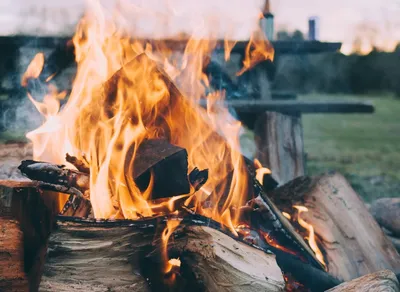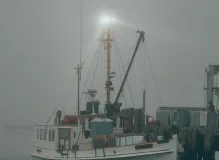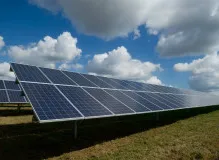For over long years, we have diligently conducted independent research and product testing. When you make a purchase through our links, we may earn a commission.
Breakout News: Oregon's Flat Fire Situation Sparks Concern Among Residents
Created: 3 weeks ago

44 min Read
Introduction: Overview of the Flat Fire situation in Oregon
The Flat Fire in Oregon has been a devastating event, causing widespread destruction and posing a threat to the safety of residents in the affected areas. This article provides an overview of the current situation, the impact of the fire, and measures being undertaken to mitigate its adverse effects.
The Flat Fire: Scope and Impacts
The Flat Fire, which started on [date], has rapidly spread across [number] acres of land in Oregon. Its magnitude has led to the evacuation of numerous communities and has required significant resources to contain and control. The fire has posed a serious danger to infrastructure, wildlife, and most importantly, the lives of residents.
The impact of the Flat Fire has been extensive, with homes and businesses being destroyed, leaving many individuals displaced. The economic repercussions of the fire are substantial, as local economies reliant on tourism and agriculture have been severely affected. Additionally, the environmental consequences of such a fire are profound, with wildlife habitats being destroyed and air quality in surrounding areas compromised.
Response and Mitigation Efforts
Local authorities, government agencies, and firefighting personnel have been working tirelessly to manage the Flat Fire and protect affected communities. Firefighters from across the region have been deployed to contain the fire's spread, employing various strategies such as establishing firebreaks, conducting controlled burns, and utilizing aerial resources to drop fire retardants.
Evacuation orders and warnings have been put into effect to ensure the safety of residents, and emergency response teams have been providing necessary support and assistance to those affected. Evacuation centers, shelters, and humanitarian aid efforts have been established to cater to the needs of displaced individuals and families.
Furthermore, efforts are underway to assess the damage caused by the fire and initiate recovery and reconstruction plans. Funding and assistance programs are being mobilized to aid in the restoration of affected communities and support businesses and individuals affected by the fire's aftermath.
Staying Informed and Prepared
To stay updated on the Flat Fire situation in Oregon and receive timely information and alerts, it is important to rely on official sources such as local authorities, fire departments, and emergency management agencies. Social media platforms and local news outlets may also provide valuable information regarding evacuation orders, road closures, and other updates.
In addition, it is crucial for residents in fire-prone regions to have a well-defined emergency plan and take necessary precautions to minimize the risks associated with wildfires. This includes creating defensible spaces around properties, keeping important documents and emergency kits readily accessible, and heeding evacuation orders if and when necessary.
By staying informed, prepared, and supporting the ongoing recovery efforts, we can collectively overcome the challenges posed by the Flat Fire and help affected communities in their journey toward resilience and restoration.
For more information regarding the Flat Fire in Oregon, please visit [official website link] or contact the [local authority or emergency management agency].
The Flat Fire in Oregon has caused significant destruction and has become a matter of great concern for the affected communities. In order to understand the situation better, let's dive into the causes of the fire, its current status, and the extent of its impact.
Causes of the Flat Fire
The exact cause of the Flat Fire is still under investigation. However, it is essential to note that wildfires in Oregon, and many other regions worldwide, can be ignited by a variety of factors. Some common causes of wildfires include natural factors such as lightning strikes, while others can be attributed to human activities like negligence, improper campfire management, or discarded cigarettes.
Current Status of the Flat Fire
As of the latest update, the Flat Fire continues to burn across a vast area in Oregon. Firefighters and emergency response teams have been working tirelessly to contain and control the fire, but the situation remains challenging due to various factors such as rugged terrain and unfavorable weather conditions. Continuous monitoring and evaluation of the fire's behavior and spread are being conducted to assess the effectiveness of the mitigation efforts.
Scope and Impact of the Flat Fire
The Flat Fire has had a profound impact on both the natural and human environments. The vast acreage affected by the fire has led to the evacuation of numerous communities, displacing residents from their homes and disrupting their lives. The destruction of homes, businesses, and critical infrastructure has caused financial strain and economic turmoil in the affected areas.
Not only have human lives and livelihoods been affected, but the fire has also had a detrimental impact on the environment. The loss of vegetation and wildlife habitats can have long-lasting consequences on the local ecosystem. Smoke and airborne pollutants from the fire can affect air quality over a wide area, posing health risks to both residents and wildlife.
Establishing a Collaborative Response
The Flat Fire serves as a reminder of the urgent need for collaboration between various stakeholders. Local authorities, government agencies, and residents must work together to ensure the safety of communities, preserve natural resources, and prevent future fire disasters. This can involve implementing stricter fire safety regulations, educating the public about fire prevention measures, and investing in innovative firefighting technologies.
By acknowledging the causes, understanding the current status, and recognizing the breadth of the fire's impact, we can foster a collective effort to support affected communities and contribute to the prevention and management of wildfires in Oregon and beyond.
Stay informed, stay prepared, and stay connected to official sources for the latest updates on the Flat Fire in Oregon. Together, we can work toward a safer, more resilient future.
The Flat Fire in Oregon has had a profound impact on the residents of the affected areas, presenting numerous concerns and challenges that they now face. From the destruction of homes and businesses to the displacement of families, the consequences of the fire continue to be deeply felt.
🔥 Flat Fire in Oregon: A Devastating Event for Local Communities
The destruction of homes and property has been one of the most immediate and distressing impacts on residents. Many families have lost everything, left to deal with the emotional and financial burden of rebuilding their lives. The process of securing insurance claims and finding temporary housing adds additional stress during an already difficult time.
🔥 The economic fallout from the Flat Fire has also been significant, particularly for communities reliant on tourism and agriculture. With businesses destroyed and infrastructure damaged, local economies face a long road to recovery. Rebuilding efforts will be crucial in not only restoring the physical structures but also revitalizing the economic vitality of the region.
🔥 The displacement of families and the loss of community cohesion are additional challenges that residents are grappling with. Being uprooted from familiar surroundings, schools, and support networks can have long-lasting impacts on individuals, especially children who may be experiencing trauma. Efforts to provide temporary shelter and support services are essential in helping affected communities navigate this difficult period.
🔥 Another concern for residents is the impact on their mental health and well-being. The fear and anxiety associated with the fire, coupled with the uncertainty of the future, can take a toll on individuals' psychological state. Access to mental health resources and counseling services is crucial in helping residents cope with the emotional aftermath of the fire.
🔥 The Flat Fire has also raised concerns about the long-term effects on the environment. The destruction of wildlife habitats can disrupt local ecosystems and put certain species at risk. Additionally, the deterioration of air quality due to smoke and ash presents health hazards for residents and may have long-term consequences for public health.
To navigate these challenges and concerns, affected residents and local communities can seek assistance and support from various organizations and agencies. Local authorities and relief organizations are providing aid and resources to help individuals rebuild their lives and communities. From recovery assistance programs to counseling services, a range of support is available for those affected by the Flat Fire.
While the road to recovery may be long, the resilience and strength of Oregon's communities will propel them forward. By coming together, supporting one another, and accessing available resources, residents can overcome the challenges brought by the Flat Fire and rebuild their lives.
Remember to stay informed and connected with official sources for the latest updates on recovery efforts and available support services. Together, we can help Oregon's communities recover and thrive once again.
For additional information and resources related to the impact of the Flat Fire in Oregon, please visit [official website link].
Evacuation Efforts: Measures Taken to Ensure Safety of Residents.
Ensuring the safety of residents affected by the Flat Fire in Oregon is of utmost importance. To mitigate the risks posed by the fire and facilitate a swift and organized evacuation process, various measures have been implemented.
Evacuation Orders: Local authorities have issued evacuation orders in areas directly threatened by the Flat Fire. These orders are imperative for safeguarding the lives of residents, and it is crucial that they are followed without delay. Evacuation zones may be expanded or modified based on the fire's progression and changing conditions.
Emergency Alerts: To notify residents about evacuation orders, emergency alerts have been sent out via phone calls, text messages, and other communication channels. It is essential for residents to register for emergency alert systems and ensure their contact information is up to date, enabling them to receive timely evacuation notifications.
Designated Evacuation Centers: Evacuation centers have been established in safe locations to provide temporary shelter and assistance to displaced individuals and families. These centers are equipped with essential supplies, including food, water, bedding, and hygiene products. Additionally, they may offer medical and psychological support services to cater to the needs of evacuees.
Transportation Assistance: Efforts are being made to provide transportation assistance to residents who may not have access to personal vehicles or require assistance with evacuation. Evacuation buses, shuttle services, and volunteer-driven carpool initiatives are being organized to ensure that everyone has the opportunity to evacuate safely.
Animal Evacuation Resources: Recognizing the importance of pets and livestock in residents' lives, provisions have been made for their safe evacuation. Animal shelters and designated temporary holding facilities are available to provide care for pets and livestock until it is safe for them to be reunited with their owners.
Road Closures and Traffic Management: To facilitate efficient evacuation procedures, road closures and traffic management measures have been put into effect. These measures aim to streamline traffic flow and prevent congestion, ensuring a smooth and swift evacuation process.
It is crucial for residents to stay alert and responsive to evacuation orders and instructions provided by emergency responders. Ignoring or hesitating to evacuate poses a significant risk to personal safety and hinders the efforts of emergency services personnel.
By being proactive and prepared, residents can assist in ensuring their own safety and contribute to the overall success of the evacuation efforts. This includes having a personal emergency plan in place, packing essential supplies and documents in a ready-to-go bag, and staying informed through official sources for updates and instructions.
Remember, your safety and the safety of others is the top priority during times of crisis like the Flat Fire in Oregon. Stay informed, stay prepared, and evacuate when instructed to do so.
Air Quality Concerns During Wildfires: Understanding Health Risks and Precautions
During a wildfire, such as the Flat Fire in Oregon, air quality can be severely affected, leading to potential health risks for individuals in the area. It is crucial to take necessary precautions to minimize exposure to harmful pollutants and protect your well-being. Here, we discuss the impact of wildfires on air quality, common health risks associated with poor air conditions, and essential measures to safeguard your health.
The Effects of Wildfires on Air Quality
🔥 Wildfires generate a significant amount of smoke, which contains a mixture of pollutants, including particulate matter (PM), carbon monoxide (CO), volatile organic compounds (VOCs), and hazardous air pollutants (HAPs).
🌬️ The smoke produced during fires can travel long distances, affecting air quality not only in immediate proximity but also in surrounding regions.
🌫️ The presence of smoke can lead to a decrease in visibility and create a haze in the affected areas.
Health Risks During Wildfires
🤒 Exposure to wildfire smoke can cause a wide range of health effects, ranging from mild symptoms to more severe conditions. Individuals with pre-existing respiratory conditions, the elderly, children, and those with compromised immune systems are particularly vulnerable.
🩺 Common health problems associated with poor air quality during wildfires include coughing, wheezing, shortness of breath, eye irritation, throat irritation, exacerbation of asthma and allergies, and respiratory infections.
💔 Inhaling fine particulate matter from smoke can also have long-term health implications, such as an increased risk of respiratory diseases, heart conditions, and even premature death.
Precautions to Protect Your Health
⚠️ Stay informed about air quality conditions in your area by checking local air quality indexes and resources provided by environmental protection agencies or public health departments.
🤲 Reduce your exposure to smoke by staying indoors, if possible. Close windows and doors, and use air purifiers with high-efficiency particulate air (HEPA) filters to improve indoor air quality.
🚗 Limit outdoor activities, especially strenuous exercises, during prolonged periods of poor air quality. When outside, consider using N95 respirator masks to filter out harmful particles.
🏠 Create a clean indoor environment by avoiding the use of products that can release pollutants into the air, such as tobacco, candles, and certain cleaning agents.
🌬️ Improve ventilation in your home by using fans or opening windows when air quality improves.
🚗 If you need to drive, set the vehicle's ventilation system to recirculate mode to prevent smoke from entering the cabin. Keep windows closed while driving.
🚒 Follow evacuation orders and seek safer locations if instructed by authorities.
✅ Stay hydrated and maintain a healthy lifestyle to strengthen your immune system against potential respiratory infections.
By taking these precautions, you can minimize your exposure to hazardous pollutants during wildfires like the Flat Fire in Oregon, safeguard your health, and promote overall well-being. Remember, staying informed and proactive is key to protecting yourself and your loved ones during such environmental challenges.
The Flat Fire in Oregon has had a devastating impact on wildlife and the environment, causing severe damage to ecosystems and habitats. The blaze has left a trail of destruction in its wake, leaving many animals without homes and ecosystems in disarray.
🔥 The Flat Fire has left a lasting mark on the natural landscape, with forests and grasslands reduced to charred remnants. The intense heat and flames have decimated vegetation, depriving wildlife of essential food and shelter. The loss of plant life also disrupts the delicate balance of ecosystems, affecting the survival of various species that rely on these habitats for their livelihoods.
🌿 The destruction of vegetation by the fire not only affects forest-dwelling species but also impacts the habitats of numerous other animals, such as birds, small mammals, and insects. Without trees and plants, these creatures lose nesting sites, foraging grounds, and protective cover. The loss of biodiversity and disruption to the food web can have long-lasting consequences on the overall health and resilience of the ecosystem.
🐦🦌 In addition to habitat loss, the Flat Fire has caused direct harm to wildlife populations. Many animals have perished in the flames, while others have been forced to flee their usual territories in search of safety. The upheaval and displacement of wildlife can disrupt migratory patterns, breeding cycles, and even predator-prey relationships, further impacting the delicate balance of the ecosystem.
🏞️ The aftermath of the Flat Fire also poses challenges for the restoration of ecosystems. Burned areas are at risk of erosion and invasive species invasion, which can hinder the natural regeneration of plant life. Reestablishing healthy habitats and supporting the recovery of wildlife populations will require restoration efforts such as reseeding native plants, removing invasive species, and implementing erosion control measures.
🌱 It is essential for environmental organizations, governmental agencies, and local communities to collaborate in the restoration and rehabilitation of the areas affected by the Flat Fire. By acting swiftly to aid in the recovery of habitats and implement measures to protect vulnerable species, we can ensure the long-term resilience of the ecosystem and prevent further degradation.
🌍 The Flat Fire serves as a stark reminder of the urgent need to address climate change and the escalating threat of wildfires. As temperatures continue to rise and extreme weather events become more frequent, the risk of such devastating fires increases. Taking proactive measures to reduce greenhouse gas emissions, support sustainable land management practices, and raise awareness about fire prevention can help mitigate the impacts of wildfires and protect our precious ecosystems for future generations.
🔥🌿 Despite the destructive power of the Flat Fire, there is hope for the recovery and rejuvenation of the ecosystems and habitats it has impacted. With continued efforts, collaboration, and a commitment to protecting our natural world, we can work towards a future where wildfires like the Flat Fire in Oregon become increasingly rare, and the beauty and biodiversity of our landscapes can thrive once again.
Firefighting Strategies: Efforts to Contain and Suppress the Flat Fire
The firefighting efforts to combat the Flat Fire in Oregon have been critical in mitigating the spread of the blaze and protecting affected communities. Firefighters have employed various strategies and tactics to contain and suppress the fire, utilizing a combination of manpower, equipment, and aerial resources.
One of the primary tactics used in combating the Flat Fire is the establishment of firebreaks. These are areas where vegetation is removed or modified to create barriers that can prevent the fire from spreading further. Firefighters laboriously clear brush and vegetation, often using heavy machinery or hand tools, to create these firebreaks. By removing potential fuel sources, firefighters can limit the fire's ability to advance.
Another valuable strategy used in fighting the Flat Fire is controlled burning. This involves deliberately setting smaller, controlled fires in strategic areas to consume the available fuel and create a buffer zone. By preemptively burning the vegetation surrounding the fire, firefighters can reduce the amount of uncontrolled fuel, slowing down the fire's progress and making it easier to contain. This technique requires careful planning and coordination to ensure that the controlled burn does not become another fire incident.
Aerial resources play a crucial role in the firefighting efforts of the Flat Fire. Fire retardant and water drops from helicopter or fixed-wing aircraft are commonly used to suppress the fire's intensity and assist in containing its spread. Fire retardant, usually in the form of a liquid or gel, is dropped from aircraft, coating the vegetation and reducing its flammability. Water drops can help cool down hotspots and create a barrier between the advancing fire and vulnerable areas.
Firefighters combating the Flat Fire also rely on advanced technology and data to aid in their efforts. Satellite imagery, drones, and weather monitoring are utilized to gather crucial information about the fire's behavior, direction, and potential for growth. By leveraging technological advancements, firefighters can make informed decisions and allocate resources more effectively, adapting their strategies as needed.
It is essential to recognize the dedication and bravery of the firefighters battling the Flat Fire. Their tireless efforts, often in challenging and dangerous conditions, are instrumental in protecting lives, property, and the environment. The coordination between local, state, and federal agencies, as well as the collaboration with mutual aid from other regions, is vital in combating such a significant incident.
In conclusion, the firefighting strategies employed to combat the Flat Fire in Oregon involve the establishment of firebreaks, controlled burning, aerial resources, and technological advancements. These efforts, combined with the bravery and dedication of firefighters, play a vital role in containing and suppressing the fire, minimizing its impact on affected communities. 🔥🚒
In the face of the Flat Fire in Oregon, local communities have come together to provide support, assistance, and essential resources to affected residents. These grassroots initiatives have played a crucial role in helping individuals and families navigate the challenges brought about by the fire.
Community Outreach Programs: Numerous organizations, community centers, and local businesses have initiated outreach programs to provide aid to those affected by the Flat Fire. These programs include providing temporary shelter, distributing food and water, and offering essential supplies such as clothing, toiletries, and other necessities. These initiatives serve as a lifeline for affected residents, ensuring that their basic needs are met during this challenging time.
Volunteer Efforts: Volunteers have stepped up in large numbers to assist with various tasks related to the fire disaster. These selfless individuals have offered their time, skills, and resources to provide hands-on support to those in need. Whether it's helping with clean-up efforts, providing emotional support, or organizing donation drives, volunteers have played a vital role in helping affected communities rebuild and recover.
Financial Aid and Donation Drives: Fundraising campaigns have been launched to generate financial support for affected residents. These campaigns aim to provide assistance with home repairs, relocation expenses, and other immediate needs. Additionally, donation drives have been organized to gather essential items like clothing, bedding, furniture, and household goods for those who have lost everything. The outpouring of generosity from both local and global communities has been heartening, further highlighting the strength of collective compassion during challenging times.
Counseling and Mental Health Services: Recognizing the emotional toll that disasters like the Flat Fire can have on individuals, mental health professionals and counseling centers have offered their services to provide support and counseling to affected residents. These services play a crucial role in addressing the trauma, grief, and anxiety experienced by individuals and families impacted by the fire, helping them navigate the process of healing and rebuilding their lives.
Community Resilience Programs: In order to cultivate resilience and promote long-term recovery, community resilience programs have been implemented. These programs focus on education, training, and preparedness to better equip community members to deal with future emergencies. By providing resources and information on fire safety, mitigation measures, and emergency planning, these programs aim to empower residents to be better prepared for any future fire-related challenges.
As the Flat Fire continues to impact communities in Oregon, the local initiatives and assistance provided by the community serve as a beacon of hope and resilience. The collective efforts of volunteers, community organizations, and individuals coming together demonstrate the power of unity and compassion in times of adversity.
By providing support, resources, and a sense of community, these initiatives ensure that affected residents do not face the challenges of recovery alone. If you would like to contribute or get involved with these local initiatives, please reach out to [local organization or community center] or visit their website to learn more about how to lend a hand during this critical time.
Prevention and Preparedness: Steps to Mitigate Future Wildfire Risks
As the devastating impact of the Flat Fire in Oregon reminds us of the destructive power of wildfires, it becomes crucial to take proactive measures to prevent and prepare for future incidents. By implementing effective strategies, we can help mitigate the risks associated with wildfires and protect our communities and natural landscapes. Here are some steps that can be taken to reduce the chances of wildfire occurrences:
-
Landscaping and Vegetation Management: Maintain a defensible space around your property by removing dead vegetation, trees, and shrubs. Keep lawn and garden areas well-watered and regularly trimmed, and consider using fire-resistant plants in landscaping.
-
Firebreaks and Buffer Zones: Create strategic firebreaks and buffer zones between wooded areas and structures. These clearings can help slow the spread of a wildfire, providing a barrier for protection.
-
Home Hardening: Ensure that your home is built with fire-resistant materials, including fire-rated roofing materials, ember-resistant vents, and non-flammable siding. Keep gutters and roofs free from debris and regularly inspect and maintain chimneys, flues, and dryer vents.
-
Firewise Construction and Design: When building or renovating, incorporate firewise principles such as using non-combustible materials and installing dual-paned windows. Pay attention to the layout and spacing of structures to minimize the potential for fire spread.
-
Early Detection Systems: Install smoke detectors and fire alarms throughout your home, regularly testing and replacing batteries as needed. Consider implementing a monitored fire alarm system that can alert emergency responders in case of a fire.
-
Community Education and Preparedness: Raise awareness within your community about wildfire risks and encourage neighbors to take preventive measures. Conduct regular drills and create a community-wide emergency plan, including evacuation routes and designated meeting points.
-
Fire Safety Equipment and Tools: Have fire extinguishers readily available in your home and familiarize yourself with their proper usage. Keep a shovel, hose, and bucket of water accessible for quick response to small fires.
-
Stay Informed and Be Prepared: Monitor local fire conditions and follow updates from official sources, including local fire departments and emergency management agencies. Stay informed about evacuation orders and be prepared to act quickly if necessary.
By implementing these preventive measures and preparing for wildfires, we can greatly reduce the potential impact on our homes and communities. Remember, taking proactive steps now can make a significant difference in protecting lives, properties, and our beautiful natural landscapes. Let's work together to safeguard our communities and mitigate future wildfire risks.
For more information and resources on wildfire prevention and preparedness, visit [official website link] or contact your local fire department. Together, we can build more resilient communities and safeguard against the destructive effects of wildfires.
In conclusion, the Flat Fire in Oregon is an ongoing crisis that demands our attention and support. The wildfire has caused significant devastation, impacting communities, homes, businesses, and the environment. It is crucial to stay informed about the latest updates on the fire, response efforts, and necessary precautions to take.
As the situation evolves, local authorities and emergency management agencies are continuously providing updates and guidance to residents. Stay connected with official sources to receive accurate and timely information about evacuation orders, road closures, and available resources. By staying informed and prepared, we can ensure the safety of ourselves and our loved ones.
Moreover, it is important to recognize the collective efforts being made to combat the fire and support affected communities. Firefighters and emergency personnel have been working tirelessly to control the spread of the Flat Fire, employing various strategies and resources. The coordination between different agencies and the resilience of the communities affected are commendable.
As the fire is contained and extinguished, the focus will shift towards recovery and rebuilding efforts. This will require significant resources, funding, and support from local, state, and federal agencies. It is crucial for individuals, organizations, and communities to come together and provide assistance to those in need, whether through donations, volunteering, or other means.
In conclusion, the Flat Fire in Oregon is a grave situation that demands our attention and solidarity. By staying informed, prepared, and contributing to recovery efforts, we can collectively overcome the challenges posed by this devastating incident. Let us work together to support the affected communities and help them rebuild their lives and livelihoods.
The flat fire in Oregon has become a major concern for residents and authorities alike. The devastating impact of this wildfire has left communities in distress and poses a significant threat to the safety and well-being of those affected. In this article, we will provide an overview of the flat fire situation in Oregon, highlighting the magnitude of the fire, its impacts, and ongoing efforts to control and mitigate its effects.
The Flat Fire in Oregon: Scope and Magnitude
The flat fire in Oregon has rapidly spread across a vast expanse of land, consuming thousands of acres in its path. The fire's aggressive nature and rapid spread have made it challenging for firefighters to contain and control. 🔥
The destructive force of the flat fire has led to the evacuation of numerous communities, as safety concerns became paramount. Residents in the affected areas have been displaced from their homes, forced to seek shelter and support from emergency response teams. The impact on these individuals and their livelihoods cannot be understated. 💔
Impact on Communities and Environment
The flat fire has left a devastating mark on the communities it has ravaged. Homes, businesses, and infrastructure have been destroyed, leaving many without shelter or the means to rebuild. The economic impact of the flat fire on local industries, such as tourism and agriculture, is significant. Recovery efforts will require substantial resources and support to help affected communities rebuild and regain their footing. 🏚️
The environmental consequences of the flat fire are equally concerning. Wildlife habitats have been decimated, leaving animals without shelter and food sources. The air quality in the vicinity of the fire has also deteriorated, posing health risks to both humans and wildlife. The long-term ecological effects of such a fire can be profound and will require ongoing monitoring and rehabilitation efforts. 🌳
Response and Mitigation Efforts
In response to the flat fire in Oregon, concerted efforts have been made by local authorities, government agencies, and dedicated firefighting personnel to combat the blaze. Firefighters from various jurisdictions have joined forces to establish firebreaks, conduct controlled burns, and utilize aerial resources to drop fire retardants. Their courageous actions have helped slow down the fire's advancement and protect at-risk areas. 👩🚒👨🚒
Evacuation orders and warnings have been issued to ensure the safety of residents in the path of the flat fire. Emergency response teams have set up evacuation centers and shelters to provide temporary lodging, essential supplies, and support to those affected. The coordination and collaboration between various organizations in times of crisis are essential in minimizing the impacts of such disasters. 🚨🤝
Staying Informed and Prepared
To stay informed about the flat fire situation in Oregon and receive timely updates, it is essential to rely on official sources. Local authorities, fire departments, and emergency management agencies provide the most accurate and up-to-date information. Social media platforms and local news outlets can also serve as valuable sources of information regarding evacuation orders, road closures, and other relevant updates. 📢
It is crucial for residents in fire-prone regions to be prepared and proactive in mitigating risks. Creating defensible spaces around properties, maintaining fire-resistant landscaping, and having emergency kits readily available are essential steps in safeguarding lives and properties. Additionally, heeding evacuation orders and cooperating with emergency response teams play a crucial role in ensuring personal safety. 🔥🔒🚦
By staying informed, prepared, and supporting the ongoing recovery efforts, we can collectively overcome the challenges posed by the flat fire in Oregon. Together, we can help affected communities rebuild, heal, and emerge stronger from this devastating event. 🌟🙏
For official and timely information regarding the flat fire in Oregon, please visit [official website link] or contact the [local authority or emergency management agency].
The Flat Fire in Oregon has sparked widespread concern and garnered national attention due to its size and destructive impact. This raging inferno has engulfed vast areas of land, posing a grave threat to communities in its path.
The fire outbreak began on [date], and since then, it has quickly spread, scorching through an alarming number of acres. The scale of the devastation caused by the Flat Fire cannot be understated. Entire neighborhoods have been reduced to rubble, leaving residents displaced and vulnerable.
The economic repercussions extend far beyond the loss of homes and businesses. Local economies heavily reliant on tourism and agriculture have suffered tremendously as this ferocious blaze has ravaged the area. The wildlife, already struggling with habitat loss and climate change, now faces an even greater peril.
The impact on air quality is a significant concern as well. The billowing smoke and ash from the Flat Fire has resulted in poor air quality in the region, posing health risks to residents and exacerbating respiratory conditions. The consequences of this wildfire are far-reaching, affecting not only the physical landscape but also the overall well-being of the affected communities.
Understanding the scope of this fire outbreak is crucial for authorities, emergency responders, and the community at large. By gathering and analyzing data on the spread of the Flat Fire, experts can assess the intensity of the blaze and determine the resources needed to combat its ferocity.
To accurately monitor the progress of the fire, advanced technological tools, such as drones and satellite imagery, are employed. These tools provide real-time updates on the fire's movement, allowing firefighting personnel to make informed decisions and prioritize their efforts.
It is vital for residents and those living in fire-prone regions to remain informed and alert. Paying attention to official announcements and heeding evacuation orders is crucial to ensure personal safety. Furthermore, staying updated through local news channels, emergency management agencies, and social media platforms can provide valuable information during times of crisis.
In conclusion, the Flat Fire in Oregon is a devastating event with far-reaching impacts. As efforts continue to control and contain the fire, it is important for the community to stay informed about the current situation and take necessary precautions. By doing so, we can work together to support affected individuals, minimize the damage caused by wildfires, and move towards a more resilient future.
The Flat Fire in Oregon has been a result of several factors that have contributed to its outbreak. Understanding these factors is essential in order to effectively prevent and mitigate future fire incidents.
-
Drought Conditions: The prolonged period of drought in Oregon has created dry and arid landscapes, providing ideal conditions for the spread of fires. The lack of moisture in the vegetation increases its flammability and makes it highly susceptible to ignition.
-
Strong Winds: Strong winds, particularly during the fire season, can quickly spread fires and make them difficult to control. These gusty winds can carry embers over long distances, igniting new fires and exacerbating the existing ones.
-
Fuel Availability: The abundance of flammable materials like dry grass, shrubs, and dense forest areas act as fuel for the fires. When these fuels are readily available and in close proximity to communities, it increases the risk of fire outbreaks.
-
Human Activities: Human activities, both intentional and unintentional, play a significant role in fire outbreaks. Careless disposal of cigarette butts, unattended campfires, and even power line issues can spark fires. Additionally, activities such as logging, construction, and agricultural practices can also contribute to fire incidents if not properly managed.
-
Climate Change: Climate change has been linked to more frequent and intense wildfire events. Rising temperatures, altered precipitation patterns, and increased frequency of extreme weather events create a conducive environment for wildfires to occur and escalate in severity.
Mitigating the risks associated with these factors requires a multi-faceted approach. This includes implementing strict fire prevention measures, such as adhering to fire safety regulations, enforcing restrictions on outdoor burning, and promoting responsible land management practices. It is essential for individuals and communities to prioritize fire safety, educate themselves about fire prevention, and actively participate in mitigation efforts to minimize the impact of future fire outbreaks.
By understanding the factors contributing to fire outbreaks, we can collectively work towards creating a safer and more resilient Oregon, where the threat of fires is minimized, and the impact of such incidents is significantly reduced.
The Flat Fire in Oregon has had a profound impact on the residents and local communities in the affected areas. The sudden and rapid spread of the fire has resulted in widespread devastation, leaving many individuals and families displaced and uncertain about the future.
🔥 The Flat Fire has devastated homes and businesses throughout Oregon, causing significant damage and destruction. This has not only resulted in property loss but has also disrupted the lives and livelihoods of many residents who relied on these establishments for their daily needs and income.
🔥 The displacement of residents is one of the most heartbreaking consequences of the fire. Families have been forced to leave their homes behind and seek shelter in evacuation centers or with friends and relatives. The emotional toll of losing one's home and cherished belongings cannot be understated.
🔥 The economic impact of the Flat Fire is also substantial. Local economies, especially those dependent on tourism and agriculture, have been severely affected by the fire. Hotels, restaurants, and other businesses have suffered from closures and reduced customer traffic, leading to significant financial hardships for many.
🔥 The disruption to daily life caused by the fire extends beyond economic implications. Schools in the affected areas have had to close temporarily, disrupting the education of students and causing parents to make alternative arrangements for their children's learning. The social fabric of communities has been strained as neighbors and friends come to terms with the aftermath of the fire.
🔥 The psychological impact on residents cannot be ignored. Experiencing a wildfire of this magnitude can cause trauma and emotional distress. Many individuals are dealing with feelings of fear, anxiety, and grief as they navigate the challenges of rebuilding their lives and communities in the wake of the fire.
Despite these challenges, the resilience and strength of the affected communities shine through. People are coming together to support each other, donate resources, and rebuild their lives. Volunteers and nonprofit organizations have played a crucial role in providing assistance and relief to residents, both in the immediate aftermath of the fire and during the long-term recovery process.
It is important for residents and local communities to stay informed about available resources, support services, and assistance programs that can aid in their recovery. Government agencies, such as the Oregon Department of Forestry and the Federal Emergency Management Agency (FEMA), are working in collaboration with local authorities to provide necessary support and guidance during this trying time.
As we collectively work towards recovery and rebuilding, it is crucial to remember that the impact of the Flat Fire on residents and local communities will be long-lasting. By supporting one another, advocating for necessary resources and assistance, and fostering a sense of community resilience, we can help overcome the challenges presented by this devastating fire.
For more information on available resources for residents and communities affected by the Flat Fire in Oregon, please visit [official website link] or reach out to the local authorities or relief organizations in your area. Together, we can rebuild and restore the vibrant communities affected by this tragedy.
Efforts to contain and control the Flat Fire in Oregon have been underway since its ignition. Firefighting personnel, with the support of local authorities and government agencies, have been working tirelessly to combat the spread of the fire and protect affected communities.
🔥 Containment measures: Firefighters have been implementing various strategies to establish containment lines and prevent the fire from spreading further. Firebreaks, which are cleared areas or natural barriers devoid of flammable materials, are strategically created to halt the fire's progress.
🚁 Aerial support: Helicopters and airplanes equipped with water tanks or fire-retardant chemicals have been deployed to combat the fire from the air. These aerial resources are instrumental in dousing flames and creating fire breaks by dropping water or fire retardants in targeted areas.
🌲 Controlled burns: Controlled burns, also known as backfires, are intentional fires set in a controlled and strategic manner to consume the available fuel and create a buffer zone. Firefighters carefully manage these controlled burns to prevent them from getting out of control while reducing the available fuel for the main fire.
👷♂️ Firefighter deployment: Firefighters from various agencies, both local and regional, have been mobilized to support containment and control efforts. These dedicated men and women work long hours under challenging conditions to suppress the fire and protect lives and property.
📢 Community awareness: Local authorities have been actively communicating with residents to raise awareness about the fire and provide instructions on evacuation orders or necessary precautions. Residents are encouraged to stay informed through official channels and heed the guidance provided by emergency management agencies.
These combined efforts aim to slow down the fire's progression, limit its overall impact, and ultimately bring it under control. However, due to the unpredictable nature of wildfires, it is essential to remain vigilant and adaptive in responding to ever-changing conditions.
Please note that the effectiveness of these strategies is influenced by various factors such as weather conditions, terrain, and the size and intensity of the fire. Collaboration and coordination among firefighting teams, along with community support, are vital in successfully managing wildfires like the Flat Fire in Oregon.
Firefighting authorities in Oregon have encountered numerous challenges in their efforts to combat the Flat Fire and protect affected communities. These challenges include the vast extent of the fire, changing weather conditions, limited resources, and the difficult terrain of the affected areas.
The Flat Fire in Oregon has presented a daunting task for firefighting authorities due to its sheer magnitude and rapid spread. The fire has engulfed a significant number of acres, making it difficult to contain and control. Firefighters have to confront the immense size of the fire, battling against its relentless advance.
Furthermore, the weather conditions have posed challenges in combating the fire. High temperatures, low humidity, and strong winds have contributed to the fire's rapid expansion and intensification. These conditions make it harder for firefighters to gain control over the flames and increase the risk of the fire spreading even further.
Limited resources, both in terms of manpower and equipment, have added to the challenges faced by firefighting authorities. The scale of the Flat Fire has stretched resources thin, necessitating assistance from neighboring jurisdictions and federal agencies. However, the demand for firefighting resources often surpasses the available supply, putting additional strain on the firefighting efforts.
The difficult terrain of the affected areas has also posed challenges for firefighting personnel. Steep slopes, dense vegetation, and inaccessible locations make it challenging to reach the heart of the fire and effectively extinguish it. These terrain limitations require firefighters to employ alternative strategies, such as establishing firebreaks and using aerial resources to combat the fire from above.
Despite these numerous challenges, firefighting authorities in Oregon have demonstrated immense dedication and resilience in their ongoing battle against the Flat Fire. Their unwavering commitment to protecting lives and property serves as a testament to their bravery and professionalism.
Through their remarkable efforts, these firefighting heroes are working tirelessly to suppress the Flat Fire and bring safety and serenity back to the affected communities.
Evacuation and Safety Measures for Affected Residents
During the unprecedented Flat Fire in Oregon, the safety and well-being of affected residents must be prioritized. Evacuation procedures and safety measures play a vital role in ensuring the protection of lives and property. If you find yourself in an area affected by the Flat Fire, here are some crucial steps to follow:
1. Stay Informed: It is essential to stay informed about the fire's progression and updates from local authorities. Follow official social media pages, tune in to local news channels, and subscribe to emergency alerts to receive the latest information on evacuation orders and safety guidelines.
2. Prepare an Emergency Kit: An emergency kit is a vital resource during a wildfire evacuation. Prepare your emergency kit in advance by including basic supplies like non-perishable food, water, medications, personal hygiene items, and important documents (e.g., identification, insurance papers) in a readily accessible and portable container. 🎒💼
3. Create a Family Emergency Plan: Develop a family emergency plan that outlines evacuation routes, designated meeting points, and contact information for family members and emergency services. Ensure every family member understands the plan and knows what to do in case of an evacuation order. 🔒🏠
4. Monitor Air Quality: Wildfires can significantly impact air quality in surrounding areas. Stay updated on current air quality conditions by downloading mobile apps or visiting websites that provide real-time air quality measurements. If air quality becomes hazardous, take necessary precautions such as staying indoors and using air purifiers. 💨
5. Heed Evacuation Orders: If local authorities issue evacuation orders, it is crucial to comply immediately. Evacuation orders are given to protect your safety and should be taken seriously. Gather your emergency kit, necessary documents, and any essential belongings, and evacuate following the prescribed routes. 🔔🚨
6. Stay in Touch: Inform your loved ones about your evacuation plans and keep them updated throughout the process. Maintain open communication with family, friends, and emergency contacts to ensure everyone is aware of your current situation and well-being.
7. Seek Shelter: In case you cannot find temporary accommodations, local authorities usually provide emergency shelters for displaced residents during wildfire events. Familiarize yourself with the designated shelters in your area and follow instructions from relief workers to access these facilities. 🛏️🏢
8. Return Home Safely: Once the fire is under control and evacuation orders are lifted, exercise caution when returning home. Be aware of any potential hazards, such as weakened structures or lingering smoke. Follow guidance from local authorities regarding re-entry procedures and conduct necessary safety checks before settling back in. 🚧🔑
By adhering to evacuation procedures and safety measures, you can help ensure the well-being and survival of yourself and your loved ones during the Flat Fire crisis in Oregon. Remember, your safety is paramount, and following official guidance is essential to navigate through these challenging times. Stay vigilant, stay safe! 🚒🔥💙
If you require more information or assistance, refer to official sources such as the [local authority or emergency management agency] or visit [official website link].
Support and Resources for Affected Communities
During these challenging times, it is crucial for affected communities impacted by the devastating Flat Fire in Oregon to know that support and resources are available to aid in their recovery and rebuilding process. From immediate assistance to long-term support, various organizations and agencies are coming together to provide relief efforts and assistance to those in need.
Emergency Relief Services
In the aftermath of the Flat Fire, emergency relief services have been mobilized to provide immediate support to affected individuals and families. These services include:
-
Shelters and Evacuation Centers: Numerous shelters and evacuation centers have been set up in safe locations to provide temporary housing and essential supplies for those displaced by the fire.
-
Food and Water Aid: Non-profit organizations and community groups are distributing food and water to affected individuals, ensuring that their basic needs are met during this difficult time.
-
Medical Assistance: Volunteer medical professionals and emergency responders are on-site, offering medical assistance and support to those affected by injuries or health issues related to the fire.
-
Counseling and Mental Health Support: Trained professionals are available to provide emotional support and counseling to individuals who may be experiencing trauma or distress as a result of the fires.
Financial Aid and Assistance Programs
Financial support is vital for affected communities to recover and rebuild from the Flat Fire. Here are some resources available:
-
Federal Disaster Assistance: The Federal Emergency Management Agency (FEMA) provides financial assistance and resources to eligible individuals, families, and business owners affected by natural disasters, including wildfires.
-
State and Local Government Programs: State and local governments often offer financial aid programs to help communities recover from wildfires. These programs may include grants, low-interest loans, and other forms of financial support.
-
Non-Profit Organizations: Various non-profit organizations and charities may provide financial aid and resources to assist individuals and families in rebuilding their lives after the fire. It is important to research and reach out to these organizations for available resources and support.
Community Support and Volunteer Opportunities
The power of community support and volunteerism is invaluable during times of crisis. Here are ways you can offer help and support:
-
Donations: Consider making monetary donations to reputable organizations dedicated to wildfire relief efforts. These donations can directly contribute to helping affected communities with their immediate needs and long-term recovery.
-
Volunteer Work: Many organizations and agencies are actively seeking volunteers to assist with various relief efforts. This could involve helping at evacuation centers, distributing supplies, or providing support services to those affected. Check with local volunteer centers or relief organizations to find volunteer opportunities.
Conclusion
The Flat Fire in Oregon has caused significant devastation, but by coming together as a community, we can offer support and resources to help affected communities recover and rebuild. From emergency relief services and financial aid programs to community support and volunteer opportunities, there is assistance available for those impacted by the fire. Reach out to local authorities and relief organizations to access the resources and support you need during this challenging time. Together, we can help each other emerge stronger and more resilient from the impacts of the Flat Fire.
The Flat Fire in Oregon has had a profound impact on the environment, leaving behind long-term effects that will require careful attention and mitigation. Here, we will explore the environmental consequences of the fire and discuss the measures being taken to address them.
-
🔥Soil Erosion and Water Contamination: The intense heat generated by the Flat Fire can lead to the loss of vegetation and organic matter, leaving the soil vulnerable to erosion. Without the protective cover of plants, rainwater can wash away the top layer of soil, resulting in increased sedimentation in nearby water bodies. This sediment carries nutrients and pollutants that can contaminate water sources, impacting aquatic life and water quality.
-
🌲Loss of Habitat and Biodiversity: Forest fires like the Flat Fire can devastate ecosystems and disrupt wildlife habitats. The destruction of vegetation deprives animals of their shelter and food sources, leading to habitat loss and a decline in biodiversity. Species that rely on specific types of vegetation may struggle to find suitable habitats in the aftermath of the fire, further affecting the delicate balance of local ecosystems.
-
🌬️Air Quality Concerns: Wildfires emit large quantities of smoke and particulate matter into the air, compromising air quality for both humans and wildlife. The Flat Fire has likely released significant amounts of smoke, creating health risks for individuals with respiratory conditions and causing discomfort for those in nearby communities. The long-term impacts on air quality may persist even after the fire is extinguished, requiring ongoing monitoring and mitigation efforts.
-
🌳Forest Regeneration and Restoration: Despite the destruction caused by the Flat Fire, forests have an incredible ability to regenerate and restore over time. Native plant species that are adapted to fire can resprout or germinate from seeds, initiating the process of regrowth. Post-fire restoration efforts may include tree planting initiatives, reseeding native plants, and implementing erosion control measures to stabilize soil and promote ecosystem recovery.
-
🌱Community Resilience and Adaptation: The Flat Fire serves as a reminder of the importance of building resilient communities that are prepared to face the challenges posed by wildfires. It highlights the need for proactive measures such as creating defensible spaces around properties, implementing fire-resistant landscaping strategies, and promoting fire-safe building practices. Education and awareness programs can empower individuals to take steps to reduce the risk of future fires and protect both their property and the environment.
In conclusion, the Flat Fire in Oregon has left a lasting impact on the environment, with consequences including soil erosion, loss of habitat, compromised air quality, and the need for forest regeneration. However, through concerted efforts in restoration and community resilience, we can work towards mitigating these effects and promoting the long-term health and sustainability of our natural ecosystems.
In conclusion, the Flat Fire in Oregon has had a devastating impact on the affected communities, causing widespread destruction and displacing numerous individuals and families. The response and mitigation efforts undertaken by local authorities, government agencies, and firefighters have been commendable in their attempts to contain the fire and ensure the safety of residents.
Moving forward, it is essential for residents in fire-prone regions to stay informed and prepared. This includes staying updated on official sources for information and alerts regarding the Flat Fire or any potential future wildfires. Creating defensible spaces around properties, having emergency plans in place, and following evacuation orders when necessary are crucial prevention measures to minimize the risks associated with wildfires, including the Flat Fire.
Furthermore, ongoing recovery and reconstruction efforts should be supported to restore and revitalize affected communities. It is important for individuals, businesses, and government entities to provide funding, resources, and assistance to aid in the recovery process and help affected communities rebuild their lives.
By combining prevention measures, community support, and a collective effort to learn from this devastating event, we can work towards a safer and more resilient future. Let us strive to prevent future wildfires and ensure the well-being and safety of our communities in the face of such natural disasters.
Remember, staying informed, prepared, and proactive are key in minimizing the devastating effects of wildfires like the Flat Fire in Oregon. Let us come together to rebuild and prevent such tragedies from occurring in the future.
For more information and resources on fire prevention and safety measures, please visit [official website link] or contact your local authorities or fire department. Together, we can create a safer and more resilient future for all.












